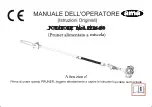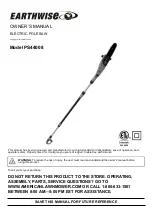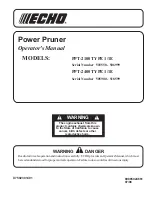
ENGLISH
39
MITRE CROSSCUT
The mitre angle angle is often 45° for making corners, but can be set
anywhere from zero to 50° left or 60° right. Proceed as for a straight
vertical crosscut.
When performing a mitre cut on workpieces wider than 51 x 105 mm
(2" x 4") that are shorter in length, always place the longer side against
the fence (fig. 19).
BEVEL CUT
Bevel angles can be set from 49° right to 49° left and can be cut with
the mitre arm set between 50° left or 60° right. Refer to the
Features
and Controls
section for detailed instructions on the bevel system.
1. Loosen the bevel lock (ee), and move the saw to the left or right as
desired. It is necessary to move the fence (n) to allow clearance.
Tighten the fence adjustment knob (m) after positioning the fences.
2. Tighten the bevel lock firmly.
At some extreme angles, the right or left side fence might have to be
removed. Refer to
Fence Adjustment
in the
Adjustments
section for
important information on adjusting the fences for certain bevel cuts.
To remove the left or right fence, unscrew the fence adjustment knob
(m) several turns and slide the fence out.
GROOVING (FIG. 1B)
Your saw is equipped with a grooving stop (bb), depth adjustment
screw (aa) and wing nut (z) to allow for groove cutting.
• Flip the grooving stop (bb) towards the front of the saw.
• Adjust the wing nut (z) and depth adjustment screw (aa) to set the
depth of the groove cut.
• Place a piece of scrap material of approx. 5 cm between fence and
workpiece in order to perform a straight groove cut.
QUALITY OF CUT
The smoothness of any cut depends on a number of variables, such as
the material being cut, blade type, blade sharpness and rate of cut.
When smoothest cuts are desired for molding and other precision work,
a sharp (60 tooth carbide) blade and a slower, even cutting rate will
produce the desired results.
WARNING:
Ensure that the material does not move or
creep while cutting; clamp it securely in place. Always let
the blade come to a full stop before raising arm. If small
fibers of wood still split out at the rear of the workpiece,
stick a piece of masking tape on the wood where the cut
will be made. Saw through the tape and carefully remove
tape when finished.
Clamping the Workpiece (fi g. 4)
WARNING:
A workpiece that is clamped, balanced
and secure before a cut may become unbalanced after
a cut is completed. An unbalanced load may tip the
saw or anything the saw is attached to, such as a table
or workbench. When making a cut that may become
unbalanced, properly support the workpiece and ensure the
saw is firmly bolted to a stable surface. Personal injury may
occur.
WARNING:
The clamp foot must remain clamped above
the base of the saw whenever the clamp is used. Always
clamp the workpiece to the base of the saw – not to any
other part of the work area. Ensure the clamp foot is not
clamped on the edge of the base of the saw.
CAUTION:
Always use a work clamp to maintain control
and reduce the risk of personal injury and workpiece
damage.
Use the material clamp (kk) provided with your saw. The left or right
fence will slide from side to side to aid in clamping. Other aids such as
spring clamps, bar clamps or C-clamps may be appropriate for certain
sizes and shapes of material.
TO INSTALL CLAMP
1. Insert it into the hole behind the fence. The clamp should be facing
toward the back of the mitre saw. The groove on the clamp rod
should be fully inserted into the base. Ensure this groove is fully
inserted into the base of the mitre saw. If the groove is visible, the
clamp will not be secure.
2. Rotate the clamp 180° toward the front of the mitre saw.
3. Loosen the knob to adjust the clamp up or down, then use the fine
adjust knob to firmly clamp the workpiece.
NOTE:
Place the clamp on the opposite side of the base when
beveling. ALWAYS MAKE DRY RUNS (UNPOWERED) BEFORE
FINISH CUTS TO CHECK THE PATH OF THE BLADE. ENSURE THE
CLAMP DOES NOT INTERFERE WITH THE ACTION OF THE SAW OR
GUARDS.
Support for Long Pieces (fi g. 7)
ALWAYS SUPPORT LONG PIECES.
For best results, use the DE7023-XJ or DE7033 leg stands (nn) to
extend the table width of your saw. Support long workpieces using any
convenient means such as sawhorses or similar devices to keep the
ends from dropping.
Cutting Picture Frames, Shadow Boxes And Other
Four-Sided Projects (fi g. 20, 21)
Try a few simple projects using scrap wood until you develop a “feel”
for your saw. Your saw is the perfect tool for mitring corners like the one
shown in figure 20.
Sketch A in figure 21 shows a joint made with the bevel adjustment
method. The joint shown can be made using either method.
• Using bevel adjustment:
–
The bevel for the two boards is adjusted to 45° each, producing a
90° corner.
–
The mitre arm is locked in the zero position and the bevel
adjustment is locked at 45°.
–
The wood is positioned with the broad flat side against the table
and the narrow edge against the fence.
• Using mitre adjustment:
–
The same cut can be made by mitring right and left with the
broad surface against the fence.
Cutting Trim Molding And Other Frames (fi g. 21)
Sketch B in figure 21 shows a joint made by setting the mitre arm at
45° to mitre the two boards to form a 90° corner. To make this type of
joint, set the bevel adjustment to zero and the mitre arm to 45°. Once
again, position the wood with the broad flat side on the table and the
narrow edge against the fence.
The two sketches in figure 21 are for four-sided objects only. As the
number of sides changes, so do the mitre and bevel angles. The chart
below gives the proper angles for a variety of shapes, assuming that all
sides are of equal length.
NUMBER OF SIDES
MITRE OR BEVEL ANGLE
4
45°
5
36°
6
30°
7
25.7°
8
22.5°
9
20°
10
18°
For a shape that is not shown in the chart, use the following formula:
180° divided by the number of sides equals the mitre (if the material is
cut vertically) or bevel angle (if the material is cut laying flat).
Cutting Compound Mitres (fi g. 22)
A compound mitre is a cut made using a mitre angle and a bevel angle
at the same time. This is the type of cut used to make frames or boxes
with slanting sides like the one shown in figure 22.
WARNING:
If the cutting angle varies from cut to cut,
check that the bevel lock knob and the mitre lock handle
are securely locked. These must be locked after making
any changes in bevel or mitre.
Содержание DWS780
Страница 1: ...www eu DWS780 ...
Страница 3: ...1 Figure 1A Figure 1B c a d g e f h j k l m o p q r s t u v w x y aa z bb cc dd ee ff gg i n b hh ...
Страница 4: ...2 Figure 4 Figure 3 Figure 2 Figure 7 Figure 6 Figure 5 ii jj kk ll mm nn ...
Страница 5: ...3 Figure 10B a pp cc Figure 10C qq Figure 10D pp rr Figure 8 Figure 9 oo Figure 10A b a ss tt cc ...
Страница 7: ...5 Figure 17B Figure 19 Figure 17A Figure 20 Figure 21 A B Figure 18 ...
Страница 8: ...6 Figure 25A n ss Figure 25B n ss Figure 24A q n q n Figure 24B ll Figure 23 Figure 22 A ...
Страница 9: ...7 Figure 26A Figure 26B Figure 27 Figure 28A a9 Figure 28B o o a m ...
Страница 165: ...163 ...
Страница 166: ...164 ...
Страница 167: ...165 ...
















































